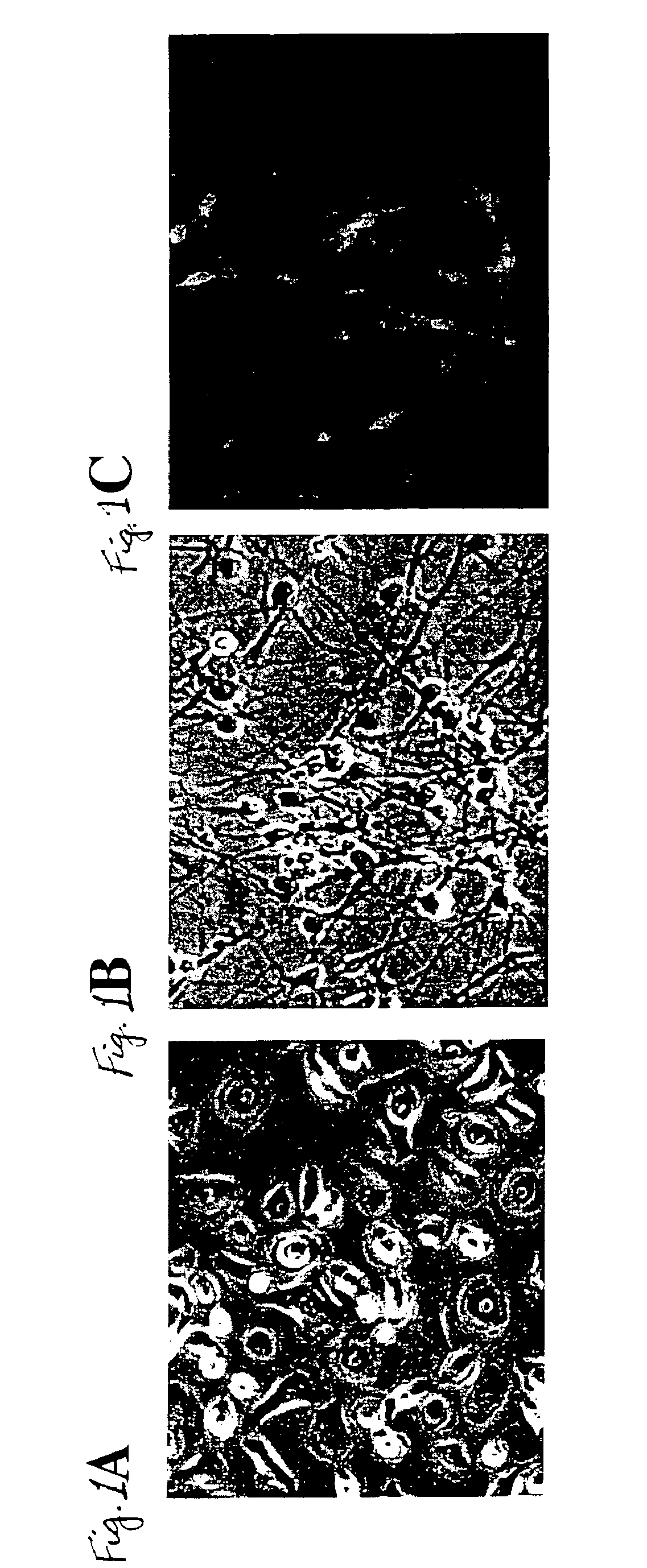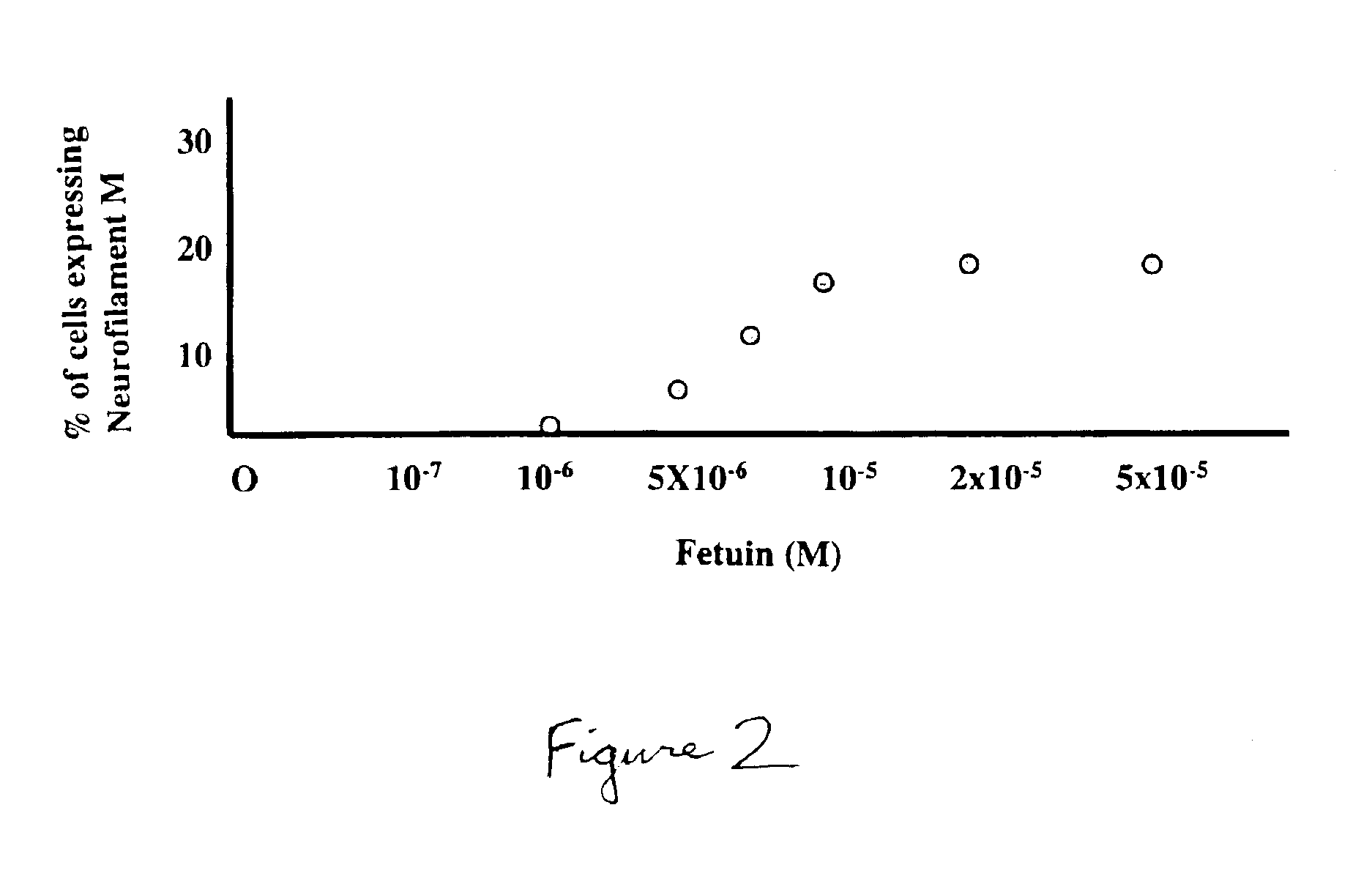Transdifferentiation of epidermal basal cells into neural progenitor cells, neuronal cells and/or glial cells
a technology of epidermal basal cells and neural progenitor cells, applied in the field of medical arts, can solve the problems of preventing the regeneration of neural tissues, hindering the development of neurological injury therapies, and limited structural self-repair potential of the central nervous system of the adul
- Summary
- Abstract
- Description
- Claims
- Application Information
AI Technical Summary
Benefits of technology
Problems solved by technology
Method used
Image
Examples
example 1
Methods
Preparation of Epidermal Cell Culture and Dedifferentiation of Cell Population.
[0084]Human adult skin was obtained from surgery procedures or skin biopsy. Before cultivation, as much as possible of the subepidermal tissue was removed by gentle scraping. Primary cultures were initiated by culturing 4-10 2×2 mm explants / 35 mm tissue culture dish in Dulbecco's modified Eagle medium (DMEM; GIBCO-BRL, Life Technologies, Inc.) with 15% fetal calf serum (GIBCO-BRL, Life Technologies, Inc.), 0.4 μg / mL hydrocortisone, and 10 ng / mL epidermal growth factor (EGF; Collaborative Research, Inc.). The medium was changed every three days. Thirty to thirty-five day old cultures were used for subsequent experimentation. Differentiated keratinized cell layers were stripped off by incubating the cultures in Ca2+-free minimal essential medium (SMEM; GIBCO-BRL, Life Technologies, Inc.). After 72 hours in calcium-free medium, suprabasal layers were detached and removed by aseptic aspiration after sh...
example 2
Transdifferentiation of Epidermal Basal Cells
[0094]Different treatment combinations were tested including fetuin (to antagonize or inhibit endogenous BMP signal transduction activity) with or without MSX1 and / or HES1 antisense oligonucleoddes (to suppress MSX1 and HES1 expression) to demonstrate transdifferentiation of epidermal basal cells into neuronal or neuron-like cells. After a 3-day treatment with the various combinations of fetuin and / or antisense oligonucleotides, cells in all treatment groups were grown in the presence of all-trans retinoic acid (10−7 M) and BDNF (20 ng / mL) for 7 additional days before immunostaining for the neural-specific antigen neurofilament M. The values in Table 1 show the relative effectiveness of the various treatments.
[0095]The results in Table 1 demonstrate that transdifferentiation of epidermal basal cells into Neurofilament M positive cells requires antagonism of BMP signal transduction by fetuin in combination with suppression of MSX1 and / or H...
example 3
Efficiency of Transdifferention Depends on the Concentration of BMP-antagonist
[0098]FIG. 2 illustrates that suppression of BMP signal transduction to allow expression of neuronal characteristics is concentration dependent with respect to the BMP antagonist. At a concentration in the medium of 1×10−5 to 5×10−5M, fetuin had maximal effect on the expression of neurofilament M by transdifferentiated cells (FIG. 2).
PUM
| Property | Measurement | Unit |
|---|---|---|
| Length | aaaaa | aaaaa |
| Molar density | aaaaa | aaaaa |
| Molar density | aaaaa | aaaaa |
Abstract
Description
Claims
Application Information
 Login to View More
Login to View More - R&D
- Intellectual Property
- Life Sciences
- Materials
- Tech Scout
- Unparalleled Data Quality
- Higher Quality Content
- 60% Fewer Hallucinations
Browse by: Latest US Patents, China's latest patents, Technical Efficacy Thesaurus, Application Domain, Technology Topic, Popular Technical Reports.
© 2025 PatSnap. All rights reserved.Legal|Privacy policy|Modern Slavery Act Transparency Statement|Sitemap|About US| Contact US: help@patsnap.com


